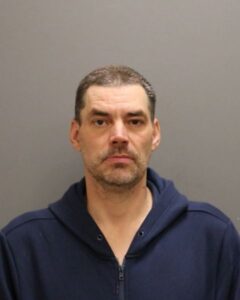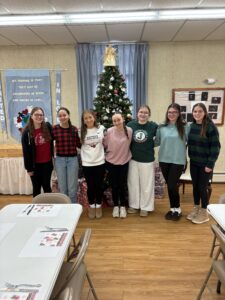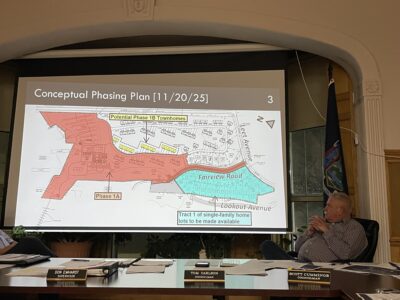Peterson Reflects On ‘Conclusion’ From RHJ Center Board

Greg Peterson addresses a packed crowd during the Jackson Center’s 10th anniversary event in 2013, during which it welcomed Chief Justice of the United States John G. Roberts, Jr. P-J file photo
There were two “aha” moments for Greg Peterson.
The first came a quarter-century ago in the square outside of Love Elementary School on Jamestown’s northside after hearing U.S. Supreme Court Justice Sandra Day O’Connor call former Jamestown resident Robert H. Jackson “one of the finest justices ever to sit on the (court’s) bench” during a statue dedication ceremony that also included Jackson’s children, William and Mary.
“To be able to listen to and meet Justice O’Connor and various family members at that event dawned on me and others of the importance of Jackson to the rule of law, both nationally and internationally, but most importantly that he was a product of our community,” Peterson, an attorney, said.
A gift from a law partner of the pre-eminent Jackson biography by author Eugene Gerhart served as the second.
“Having read about him through the biography, coupled with seeing a justice of such high esteem regard him so highly, you can’t help but wonder ‘Gee, we ought to learn more about the man,” Peterson reflected.

Jamestown attorney Greg Peterson, co-founder of the Robert H. Jackson Center, stands with a Dexter Benedict bust of the late Nuremberg prosecutor and Supreme Court Justice. Peterson stepped down from the center’s board in December after 20 years of working to turn a concept into a reality. P-J photo by Cameron Hurst
Twenty years later, the red brick institution that bears Jackson’s name that has ingrained the late legal giant’s legacy, nearly lost to history, into the fabric of the greater Jamestown and community and beyond symbolizes that mission’s accomplishment.
For Peterson, though, the milestone symbolizes a bookend — the Robert H. Jackson Center announced his decision to step away from its board of directors on Dec. 14, the exact date of its inception that came following a meeting with local benefactors Carl Cappa and Elizabeth Lenna and then-director of the Gebbie Foundation, Tom Cardman.
“I chose to make that my last day as a member of the board of directors as just a nice symmetry of process,” Peterson said. “What began as a concept … now is concrete and now, 20 years later, we hold sustainable. You not only have a flood of memories, but a tsunami of memories over these last 20 years which include the thousands of volunteers, the hundreds of programs, the number of dedicated board members, staff members, all who have been working on one project — advancing the legacy of Robert Jackson.”
“Greg is a phenomenal storyteller, and one of my favorites to hear him recount is the genesis of the Jackson Center …. Of course, that is not all one story, so you need to settle in and get comfortable,” Jackson Center President Kristan McMahon chuckled. “But that storyteller instinct — drive might be a more accurate word — isn’t just for Justice Jackson’s story or the Center’s story. He wants everyone to have the opportunity to share their stories because each and every one is impactful. That’s a very Jacksonian way of walking through this world.”
Peterson’s first inkling to begin documenting Jackson’s Jamestown footprint came just prior to that meeting in documenting the members of the Jamestown Bar Association, still living, who had attended the justice’s 1954 funeral at St. Luke’s Episcopal Church. The service had been attended by all eight sitting justices of the United State Supreme Court.
“These were icons in judicial history and they were here in Jamestown, New York,” Peterson said. “I thought that was a historical event that not many people knew of but was of great significance so I tried to document it by those attorneys who had gone out and had lunch with these guys and had met them.”
Soon, the inaugural board of directors, which also consisted of Jackson nephew Harold Adams and former surrogate court judge Willard Cass Jr., acquired the former Scottish Rite Consistory on East Fourth Street and converted it into its home. The statue once dedicated by O’Connor now sits on the center’s front lawn.
By the spring of 2003, Chief Justice of the United States and former Jackson law clerk, William Rehnquist, visited the center to help dedicate it. Ten years later, Rehnquist’s successor, current-Chief Justice John Roberts, visited to celebrate its anniversary. The center, meanwhile, continues to hold programming honoring pivotal Jackson decisions — Brown v. Board of Education, West Virginia v. Barnette and Korematsu v. United States.
“All of these events have given the Robert H. Jackson Center credibility and have enhanced the Jackson legacy,” Peterson said. “To have the people who were behind those decisions and the law clerks who were behind it as well was remarkable and then to annually have all the chief prosecutors of the international tribunals, which have included the Nuremberg Trials, to come here — it’s just It’s impossible to highlight anything because you’re going to leave out something, because you’re going to leave out something that deserves equal protection.”
Meanwhile, Jackson Center officials have visited Moscow, Nuremberg and various cities that honor Jackson. The U.S. Federal courthouse in Buffalo, opened in 2012, also bears the late jurist’s name, and a Jackson bust was delivered to the United States Supreme Court.
“All of these things had not occurred before and we did most of that in 20 years,” Peterson said. “It’s only now do you really look back and say ‘Much has happened.'”
He quickly deflects the credit, though, saying “This isn’t me. We kept moving forward. We needed a village and so many people were willing to give their time, energies and effort to make this all a reality and it continues to be that way.”
“This has never been a mere passion project,” McMahon added. “Greg had a vision to preserve Justice Jackson’s legacy, to show that legacy reflected in the people of Jamestown, the United States, and the world, historically and today, and to amplify Jackson’s voice and thoughts to shine a light on the challenges we’re still grappling with now. I think he feels a tremendous amount of responsibility to this work, and I hope he also feels a corresponding amount of pride.”
She added, “It is no small thing to say that the Jackson Center would not be what it is, likely would not even exist, without the amazing heart of Greg Peterson.”
And while he plans to step away, Peterson is confident in the center’s vision moving forward, led by McMahon and center board chair Leah Weinberg.
“I think that the first 20 years at least focused a lot on who Robert Jackson was, what he did and how that’s relevant today,” he said. “We were able to interact with many people who had firsthand knowledge of Jackson and were the first generation of Jackson’s reach. That time has passed and I am thrilled that our current leadership under Kristan McMahon has pivoted this to various social media platforms, various subjects that relate to Jackson, but are more relevant to today’s rule of law issues and that gives me great hope.”
He calls his decision a “conclusion” from his time on the board and not a “departure” from the center itself.
“They have my phone number and I have theirs,” he laughed. “I will still obviously be a supporter and will probably not be shy about sharing a thought or two, but I leave the board with the comfort that under (McMahon and Weinberg’s leadership) that we are in very good hands and that the Jackson Center is in an exciting position for the next 20 years.”
Still, he thinks back to that day at Love Elementary School often.
“As a product of our community, Justice O’Connor said we should be justly proud of Jackson,” he said. “Maybe I took that to heart.”
- Greg Peterson addresses a packed crowd during the Jackson Center’s 10th anniversary event in 2013, during which it welcomed Chief Justice of the United States John G. Roberts, Jr. P-J file photo
- Jamestown attorney Greg Peterson, co-founder of the Robert H. Jackson Center, stands with a Dexter Benedict bust of the late Nuremberg prosecutor and Supreme Court Justice. Peterson stepped down from the center’s board in December after 20 years of working to turn a concept into a reality. P-J photo by Cameron Hurst







